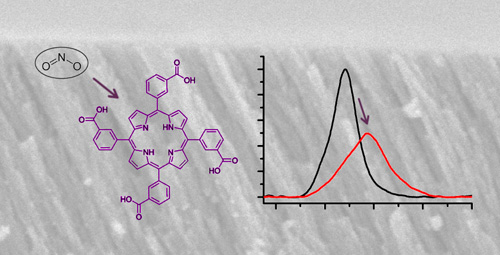J. Roales, J.M. Pedrosa, M.G. Guillén, T. Lopes-Costa, P. Castillero, A. Barranco, A.R. González-Elipe
Sensors, 15 (2015) 11118-11132
doi: 10.3390/s150511118
The anchoring effect on free-base carboxyphenyl porphyrin films using TiO2 microstructured columns as a host matrix and its influence on NO2 sensing have been studied in this work. Three porphyrins have been used: 5-(4-carboxyphenyl)10,15,20-triphenyl-21H,23H-porphyrin (MCTPP); 5,10,15,20-tetrakis(4-carboxyphenyl)-21H,23H-porphyrin (p-TCPP); and 5,10,15,20-tetrakis(3-carboxyphenyl)-21H,23H-porphyrin (m-TCPP). The analysis of UV-Vis spectra of MCTPP/TiO2, p-TCPP/TiO2 and m-TCPP/TiO2 composite films has revealed that m-TCPP/TiO2 films are the most stable, showing less aggregation than the other porphyrins. IR spectroscopy has shown that m-TCPP is bound to TiO2 through its four carboxylic acid groups, while p-TCPP is anchored by only one or two of these groups. MCTPP can only be bound by one carboxylic acid. Consequently, the binding of p-TCPP and MCTPP to the substrate allows them to form aggregates, whereas the more fixed anchoring of m-TCPP reduces this effect. The exposure of MCTPP/TiO2, p-TCPP/TiO2 and m-TCPP/TiO2 films to NO2 has resulted in important changes in their UV-Vis spectra, revealing good sensing capabilities in all cases. The improved stability of films made with m-TCPP suggests this molecule as the best candidate among our set of porphyrins for the fabrication of NO2 sensors. Moreover, their concentration-dependent responses upon exposure to low concentrations of NO2 confirm the potential of m-TCPP as a NO2 sensor.


